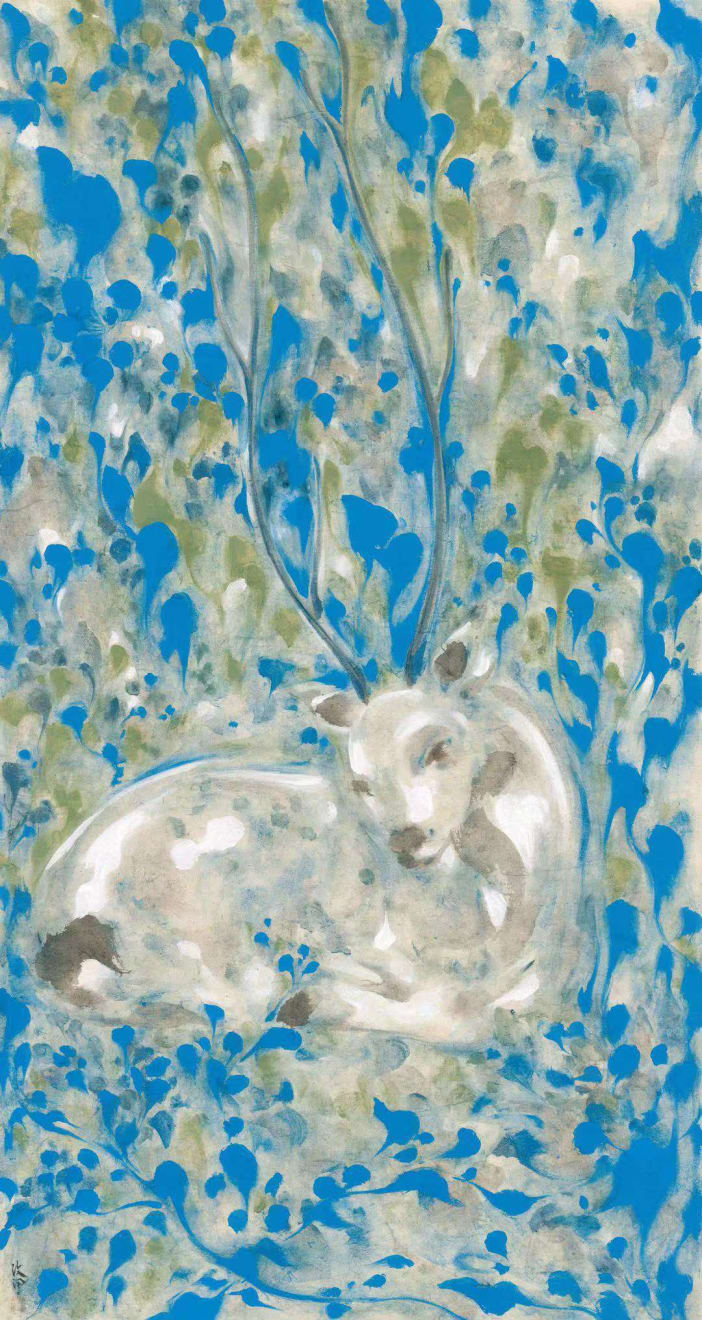Pan Wenxun 潘汶汛
Piedmont 麓, 2019
Ink and colour on paper 水墨設色紙本
142 x 76 cm
Copyright The Artist
潘汶汛的浪漫,就建立在她對古老傳統藝術的吸收,對事物內在本質的洞察,對所處時代詩意的想像。鹿、孩子、植物都是潘汶汛所喜愛使用的意象,也都是未經摻雜的、平淡天真的事物代表,純潔且生機勃勃。她用畫筆勾勒了其獨有的、神性的精神世界,在紙面上營造了一種牽動人心、極富野趣的境界。作品《麓》,選用了林中之鹿的意象,用筆極為溫潤,在一片墨氣宜人的蓼藍中,一頭鹿自得地蜷軀,輕輕歪著脖子。「麓」一字本身意味著鹿的棲息之地,即有樹林、有水、有草的山腳。它幽居山林,安于自然,是古代隱士的恬淡象徵,是佛教文化的慈悲仙獸,也是潘汶汛獨立於世的浪漫態度,是一種個體精神性的悠然與佇立。 Through new works, Pan's interpretation of romance is based on her adaptation of ancient traditional art and appreciation of nature. As unadulterated and innocent representations of things that are...
潘汶汛的浪漫,就建立在她對古老傳統藝術的吸收,對事物內在本質的洞察,對所處時代詩意的想像。鹿、孩子、植物都是潘汶汛所喜愛使用的意象,也都是未經摻雜的、平淡天真的事物代表,純潔且生機勃勃。她用畫筆勾勒了其獨有的、神性的精神世界,在紙面上營造了一種牽動人心、極富野趣的境界。作品《麓》,選用了林中之鹿的意象,用筆極為溫潤,在一片墨氣宜人的蓼藍中,一頭鹿自得地蜷軀,輕輕歪著脖子。「麓」一字本身意味著鹿的棲息之地,即有樹林、有水、有草的山腳。它幽居山林,安于自然,是古代隱士的恬淡象徵,是佛教文化的慈悲仙獸,也是潘汶汛獨立於世的浪漫態度,是一種個體精神性的悠然與佇立。
Through new works, Pan's interpretation of romance is based on her adaptation of ancient traditional art and appreciation of nature. As unadulterated and innocent representations of things that are pure and vibrant, Pan uses her brush to outline her unique and divine spiritual world, attaching a poetic softness to her subject matters, usually focused around children, woodland animals and flora.
In her work Piedmont, a seated deer in the forest is enveloped with warm swirls of colour showcasing her relaxed brushwork and technique. The Chinese word ‘Lu’ (麓) means the deer's habitat, such as ‘at the foot’ of a mountain in the woods, by the water, and or surrounded by grass, hence the title. The piece is also a representation of tranquillity, a Buddhist culture's spiritual animal of compassion, an individual’s spirituality of life and its meaning – which is Pan’s romantic approach of independence from the world as we know it.
Through new works, Pan's interpretation of romance is based on her adaptation of ancient traditional art and appreciation of nature. As unadulterated and innocent representations of things that are pure and vibrant, Pan uses her brush to outline her unique and divine spiritual world, attaching a poetic softness to her subject matters, usually focused around children, woodland animals and flora.
In her work Piedmont, a seated deer in the forest is enveloped with warm swirls of colour showcasing her relaxed brushwork and technique. The Chinese word ‘Lu’ (麓) means the deer's habitat, such as ‘at the foot’ of a mountain in the woods, by the water, and or surrounded by grass, hence the title. The piece is also a representation of tranquillity, a Buddhist culture's spiritual animal of compassion, an individual’s spirituality of life and its meaning – which is Pan’s romantic approach of independence from the world as we know it.
3
之
3
